
Leon Max Lederman was an American experimental physicist who received the Nobel Prize in Physics in 1988, along with Melvin Schwartz and Jack Steinberger, for research on neutrinos. He also received the Wolf Prize in Physics in 1982, along with Martin Lewis Perl, for research on quarks and leptons. Lederman was director emeritus of Fermi National Accelerator Laboratory (Fermilab) in Batavia, Illinois. He founded the Illinois Mathematics and Science Academy, in Aurora, Illinois in 1986, where he was resident scholar emeritus from 2012 until his death in 2018.

Brookhaven National Laboratory (BNL) is a United States Department of Energy national laboratory located in Upton, New York, a hamlet of the Town of Brookhaven. It was formally established in 1947 at the site of Camp Upton, a former U.S. Army base on Long Island. Located approximately 60 miles east of New York City, it is managed by Stony Brook University and Battelle Memorial Institute.
A timeline of atomic and subatomic physics, including particle physics.

Maria Goeppert Mayer was a German-American theoretical physicist and Nobel laureate in Physics for proposing the nuclear shell model of the atomic nucleus. She was the second woman to win a Nobel Prize in Physics, the first being Marie Curie. In 1986, the Maria Goeppert-Mayer Award for early-career women physicists was established in her honor.

The muon neutrino is an elementary particle which has the symbol
ν
μ and zero electric charge. Together with the muon it forms the second generation of leptons, hence the name muon neutrino. It was discovered in 1962 by Leon Lederman, Melvin Schwartz and Jack Steinberger. The discovery was rewarded with the 1988 Nobel Prize in Physics.
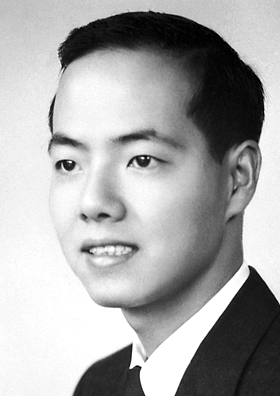
Tsung-Dao Lee was a Chinese-American physicist, known for his work on parity violation, the Lee–Yang theorem, particle physics, relativistic heavy ion (RHIC) physics, nontopological solitons, and soliton stars. He was a university professor emeritus at Columbia University in New York City, where he taught from 1953 until his retirement in 2012.
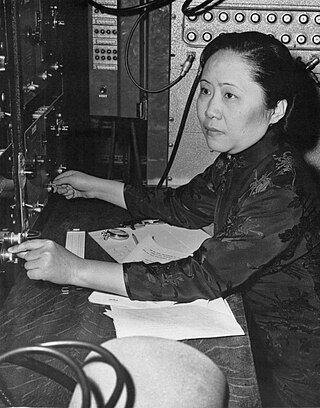
Chien-Shiung Wu (Chinese: 吳健雄; pinyin: Wú Jiànxióng; Wade–Giles: Wu2 Chien4-Shiung2; May 31, 1912 – February 16, 1997) was a Chinese-American particle and experimental physicist who made significant contributions in the fields of nuclear and particle physics. Wu worked on the Manhattan Project, where she helped develop the process for separating uranium into uranium-235 and uranium-238 isotopes by gaseous diffusion. She is best known for conducting the Wu experiment, which proved that parity is not conserved. This discovery resulted in her colleagues Tsung-Dao Lee and Chen-Ning Yang winning the 1957 Nobel Prize in Physics, while Wu herself was awarded the inaugural Wolf Prize in Physics in 1978. Her expertise in experimental physics evoked comparisons to Marie Curie. Her nicknames include the "First Lady of Physics", the "Chinese Madame Curie" and the "Queen of Nuclear Research".
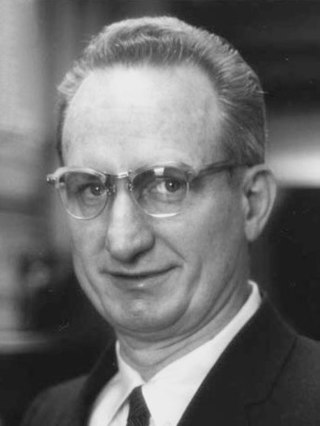
Leo James Rainwater was an American physicist who shared the Nobel Prize in Physics in 1975 for his part in determining the asymmetrical shapes of certain atomic nuclei.

Val Logsdon Fitch was an American nuclear physicist who, with co-researcher James Cronin, was awarded the 1980 Nobel Prize in Physics for a 1964 experiment using the Alternating Gradient Synchrotron at Brookhaven National Laboratory that proved that certain subatomic reactions do not adhere to fundamental symmetry principles. Specifically, they proved, by examining the decay of K-mesons, that a reaction run in reverse does not retrace the path of the original reaction, which showed that the reactions of subatomic particles are not indifferent to time. Thus the phenomenon of CP violation was discovered. This demolished the faith that physicists had that natural laws were governed by symmetry.

The Institute for Nuclear Studies was founded September 1945 as part of the University of Chicago with Samuel King Allison as director. On November 20, 1955, it was renamed The Enrico Fermi Institute for Nuclear Studies. The name was shortened to The Enrico Fermi Institute (EFI) in January 1968.

Jack Steinberger was a German-born American physicist noted for his work with neutrinos, the subatomic particles considered to be elementary constituents of matter. He was a recipient of the 1988 Nobel Prize in Physics, along with Leon M. Lederman and Melvin Schwartz, for the discovery of the muon neutrino. Through his career as an experimental particle physicist, he held positions at the University of California, Berkeley, Columbia University (1950–68), and the CERN (1968–86). He was also a recipient of the United States National Medal of Science in 1988, and the Matteucci Medal from the Italian Academy of Sciences in 1990.
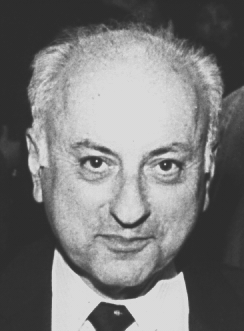
Melvin Schwartz was an American physicist. He shared the 1988 Nobel Prize in Physics with Leon M. Lederman and Jack Steinberger for their development of the neutrino beam method and their demonstration of the doublet structure of the leptons through the discovery of the muon neutrino.

Pupin Physics Laboratories, also known as Pupin Hall, is home to the physics and astronomy departments of Columbia University in New York City. The building is located on the south side of 120th Street, just east of Broadway. In 1965, Pupin was named a National Historic Landmark for its association with experiments relating to the splitting of the atom, achieved in connection with the later Manhattan Project. In 2009 the American Physical Society named Pupin Hall a historic site and honored Isidor Isaac Rabi for his work in the field of magnetic resonance.

LotharWolfgang Nordheim was a German-born Jewish American theoretical physicist. He was a pioneer in the applications of quantum mechanics to solid-state problems, such as thermionic emission, work function of metals, field electron emission, rectification in metal-semiconductor contacts and electrical resistance in metals and alloys. He also worked in the mathematical foundations of quantum mechanics, cosmic rays and in nuclear physics.
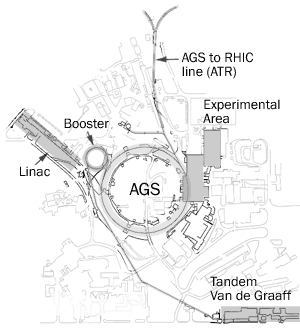
The Alternating Gradient Synchrotron (AGS) is a particle accelerator located at the Brookhaven National Laboratory in Long Island, New York, United States.

Herbert Lawrence Anderson was an American nuclear physicist who was Professor of Physics at the University of Chicago.
Eugene Theodore Booth, Jr. was an American nuclear physicist. He was a member of the historic Columbia University team which made the first demonstration of nuclear fission in the United States. During the Manhattan Project, he worked on gaseous diffusion for isotope separation. He was the director of the design, construction, and operation project for the 385-Mev synchrocyclotron at the Nevis Laboratories, the scientific director of the SCALANT Research Center, and dean of graduate studies at Stevens Institute of Technology. Booth was the scientific director of the SCALANT Research Center, in Italy.
The timeline of quantum mechanics is a list of key events in the history of quantum mechanics, quantum field theories and quantum chemistry.

Luigi Di Lella is an Italian experimental particle physicist. He has been a staff member at CERN for over 40 years, and has played an important role in major experiments at CERN such as CAST and UA2. From 1986 to 1990 he acted as spokesperson for the UA2 Collaboration, which, together with the UA1 Collaboration, discovered the W and Z bosons in 1983.
Science tourism is a travel topic grouping scientific attractions. It covers interests in visiting and exploring scientific landmarks, including museums, laboratories, observatories and universities. It also includes visits to see events of scientific interest, such as solar eclipses.
This article is an adaptation of the summarized history found at the Columbia University physics department homepage:


















